Chapter 4 – Measurement of Matter
1. Give examples.
a. Positive radicals
Ans: Na⁺ – Sodium, K⁺ – Potassium
b. Basic radicals
Ans: Na⁺ – Sodium, K⁺ – Potassium
c. Composite radicals
Ans: SO₄²⁻, NH₄⁺
d. Metals with variable valency
Ans:
(i) Iron (Ferrum)
(a) Fe²⁺ – Ferrous [Iron – II]
(b) Fe³⁺ – Ferric [Iron – III]
(ii) Copper (Cuprum)
(a) Cu⁺ – Cuprous [Copper – I]
(b) Cu²⁺ – Cupric [Copper – II]
e. Bivalent acidic radicals
Ans: O²⁻ – Oxide, S²⁻ – Sulphide
f. Trivalent basic radicals
Ans: Al³⁺ – Aluminium, Cr³⁺ – Chromium
2. Write symbols of the following elements and the radicals obtained from them, and indicate the charge on the radicals.
Mercury
Potassium
Nitrogen
Copper
Sulphur
Carbon
Chlorine
Oxygen
Ans:

3. Write the steps in deducing the chemical formulae of the following compounds.
Sodium sulphate
Ans:
Step 1 : To write the symbols of the radicals (Basic radicals on the left and acidic radicals on the right)
Na SO₄
Step 2 : To write the valency below the respective radical.
Na SO₄
1 2
Step 3 : To cross multiply as shown by arrows the number of radicals.
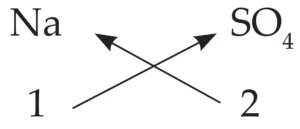
Step 4 : To write down the chemical formula of the compound.
Na₂SO₄
(Sodium Sulphate)
Potassium nitrate
Ans:
Step 1 : To write the symbols of the radicals (Basic radicals on the left and acidic radicals on the right)
K NO₃
Step 2 : To write the valency below the respective radical.
K NO₃
1 1
Step 3 : To cross multiply as shown by arrows the number of radicals.
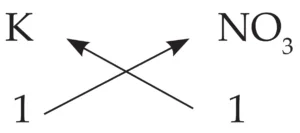
Step 4 : To write down the chemical formula of the compound.
KNO₃
(Potassium Nitrate)
Ferric phosphate
Ans:
Step 1 : To write the symbols of the radicals (Basic radicals on the left and acidic radicals on the right)
Fe PO₄
Step 2 : To write the valency below the respective radical.
Fe PO₄
3 3
1 1
(Dividing valency by common factor)
Step 3 : To cross multiply as shown by arrows the number of radicals.
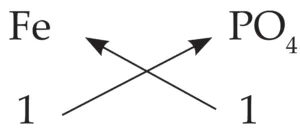
Step 4 : To write down the chemical formula of the compound.
FePO₄
(Sodium Sulphate)
Calcium oxide
Ans:
Step 1 : To write the symbols of the radicals (Basic radicals on the left and acidic radicals on the right)
Ca O
Step 2 : To write the valency below the respective radical.
Ca O
1 2
Step 3 : To cross multiply as shown by arrows the number of radicals.
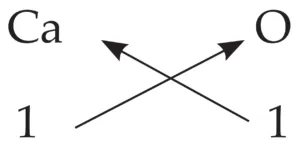
Step 4 : To write down the chemical formula of the compound.
CaO
(Calcium Oxide)
Aluminium hydroxide
Ans:
Step 1 : To write the symbols of the radicals (Basic radicals on the left and acidic radicals on the right)
Al OH
Step 2 : To write the valency below the respective radical.
Al OH
3 1
Step 3 : To cross multiply as shown by arrows the number of radicals.
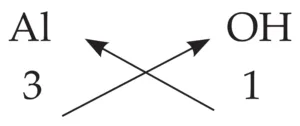
Step 4 : To write down the chemical formula of the compound.
(Al(OH)₃)
(Aluminium hydroxide)
4. Write answers to the following questions and explain your answers.
a. Explain the monovalency of the element sodium.
Ans:
(i) The number of protons or electrons (atomic number) in a Sodium (Na) atom is 11. Therefore the electronic configuration of sodium atom is (2, 8, 1).
(ii) In chemical reaction, sodium atom has the capacity to give away 1e⁻ from its outermost orbit to form Na⁺ ion with stable electronic configuration (2, 8).
(iii) As sodium atom gives away 1e⁻ and a cation of sodium is formed, hence the valency of sodium is 1 and therefore the element sodium is monovalent.
b. M is a bivalent metal. Write down the steps to find the chemical formulae of its compounds formed with the radicals : sulphate and phosphate
Ans: M is a bivalent metal. Following are the steps to find the chemical formulae of its compounds formed with the radicals, sulphate and phosphate:
(i) Compound of metal ‘M’ with radical sulphate:
Step 1: To write the symbols of the radicals. (Basic radicals on the left and acidic radicals on the right)
M SO₄
Step 2: To write the valency below the respective radical
M SO₄
2 2
1 1
(Dividing valency by common factor)
Step 3: To cross multiply as shown by arrows the number of radicals

Step 4: To write down the chemical formula of the compound.
MSO₄
(ii) Compound of metal ‘M’ with radical phosphate:
Step 1: To write the symbols of the radicals. (Basic radicals on the left and acidic radicals on the right)
M PO₄
Step 2: To write the valency below the respective radical
M PO₄
2 3
Step 3: To cross multiply as shown by arrows the number of radicals.
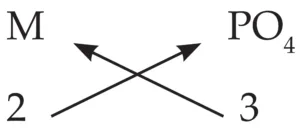
Step 4: To write down the chemical formula of the compound.
M₃(PO₄)
c. Explain the need for a reference atom for atomic mass. Give some information about two reference atoms.
Ans:
(i) The mass of an atom is concentrated in its nucleus and it is due to the protons (p) and neutrons (n) in it.
(ii) An atom is very very tiny. It was not possible to measure atomic mass accurately. Therefore, the concept of relative mass of an atom was formed.
(iii) To express relative mass of an atom, reference of atom is considered. The two reference atoms were as follows:
(a) Hydrogen (H) atom:
The hydrogen atom is the lightest. The relative mass of a hydrogen atom is 1 which has only 1 proton in its nucleus. On this scale, the relative atomic mass of many elements comes out to be fractional. Therefore, carbon is selected as a reference atom.
(b) Carbon (C) atom :
The carbon atom is selected as a reference atom. In this scale, the relative mass of a carbon atom is accepted as 12.
(iv) The relative atomic mass of 1 hydrogen (H) atom compared to the carbon (C) atom becomes 12 × \(\large \frac {1}{12}\) i.e. ‘1’.
d. What is meant by Unified Atomic Mass?
Ans:
(i) During earlier times, relative mass of an atom was considered for measuring the mass of an atom directly. But since the founding of unified mass, relative mass is not accepted henceforth.
(ii) Unified atomic mass is the unit of atomic mass called Dalton.
(iii) Its symbol is ‘u’. 1u = 1.66053904 × 10⁻²⁷ kg.
e. Explain with examples what is meant by a ‘mole’ of a substance.
Ans:
(i) A mole is that quantity of a substance whose mass in grams is equal in magnitude to the molecular mass of that substance in Daltons.
(ii) For example: Atomic mass of oxygen atom (O) is 16u. Thus the molecular mass of the oxygen molecule (O₂) is 16 × 2 = 32u. Therefore 32 g of oxygen is 1 mole of oxygen.
5. Write the names of the following compounds and deduce their molecular masses.
Na₂SO₄
Ans:0

K₂CO₃
Ans:

CO₂
Ans:

MgCl₂
Ans:

NaOH
Ans:

AlPO₄
Ans:

NaHCO₃
Ans:

6. Two samples ‘m’ and ‘n’ of slaked lime were obtained from two different reactions. The details about their composition are as follows:
‘sample m’ mass : 7g
Mass of constituent oxygen : 2g
Mass of constituent calcium : 5g
‘sample n’ mass : 1.4g
Mass of constituent oxygen : 0.4g
Mass of constituent calcium : 1.0g
Which law of chemical combination does this prove? Explain.
Ans:
(i) The expected proportion by weight of the constituent elements of quick lime that is calcium oxide would be from its known molecular formula CaO. The atomic mass of Ca and O are 40 and 16 respectively. This means, the proportion by weight of the constituent elements Ca and O in the compound CaO is 40 : 16 which is 5 : 2.
(ii) Now, for the given sample ‘m’ of CaO = 5g
mass of given sample = 7g
mass of constituent Ca in sample ‘m’ = 5g mass of constituent O in sample ‘m’ = 2g
(iii) This means that 7g of calcium oxide contains 5g of calcium (Ca) and 2g of oxygen (O); and the proportion by weight of calcium and oxygen in it is 5 : 2.
(iv) Now, for the given sample ‘n’ of CaO mass of given sample CaO = 1.4 g
Mass of constituent Ca in sample ‘n’ = 1.0 g
Mass of constituent O in sample ‘n’ = 0.4 g
This means that 1.4g of calcium oxide contains 1.0 g of calcium (Ca) and 0.4g of oxygen (O); and the proportion by weight of calcium and oxygen in it is 5 : 2.
(v) Above samples ‘m’ and ‘n’ of calcium oxide (CaO) shows that the proportion by weight of the constituent elements in different samples of a compound is always constant that is the proportion by weight of calcium (Ca) and oxygen (O) in different samples of calcium oxide (CaO) is constant.
(vi) The experimental value of proportion by weight of the constituent elements matched with the expected proportion calculated by molecular mass. This proves and verifies the law of constant proportion. The law states that ‘The proportion by weight of the constituent elements in the various samples of a compound is fixed’.
7. Deduce the number of molecules of the following compounds in the given quantities.
32g oxygen
Given :
Mass of oxygen = 32g
To find :
Number of molecules in 32g of oxygen.
Solution :
Atomic mass of oxygen (O) = 16
∴ Molecular mass of oxygen (O₂) = 16 × 2 = 32
According to the formula,
Number of moles in the given O₂ (n)
= \(\large \frac {Mass\, of\, O₂\, in\, grams
}{Molecular\, mass \,of \,O₂}\)
= \(\large \frac {32}{32}\)
= 1
∴ n = 1 mol
∴ 1 mol of O₂ contains 6.022 × 10²³ molecules that is 32 g of O₂ contains 6.022 × 10²³ molecules of O₂.
That is, 32g of oxygen contains 6.022 × 10²³ molecules of oxygen.
90g water
Given :
Mass of water (H₂O) = 90g.
To find :
Number of molecules in 90g of water.
Solution :
Molecular mass of (H₂O) = (Atomic mass of H) × 2 + (Atomic mass of O) × 1
∴ Molecular mass of H₂O = 1 × 2 + 16
∴ Molecular mass of H₂O = 18
According to the formula,
Number of moles in the given H₂O (n)
= \(\large \frac {Mass\, of\, H₂O\, in\, grams}{Molecular\, mass \,of \,H₂O}\)
= \(\large \frac {90}{18}\)
= 5
∴ n = 5 mol
∴ 1 mol of H₂O contains 6.022 × 10²³ molecules.
∴ 5 mol of H₂O contains,
5 × 6.022 × 10²³ = 30.11 × 10²³ molecules.
That is, 90g of water contains 30.11 × 10²³ molecules of water.
8.8g carbon dioxide
Given :
Mass of Carbon dioxide (CO₂) = 8.8g.
To find :
Number of molecules in 8.8g of carbon dioxide.
Solution :
Molecular mass of (CO₂) = (Atomic mass of C) × 1 + (Atomic mass of O) × 2
∴ Molecular mass of CO₂
= 12 × 1 + 16 × 2
= 12 + 32
= 44
According to the formula,
Number of moles in the given CO₂ (n)
= \(\large \frac {Mass\, of\, CO₂\, in\, grams}{Molecular\, mass \,of \,CO₂}\)
= \(\large \frac {8.8}{44}\)
= 0.2
∴ n = 0.2 mol
∴ 1 mol of CO₂ contains 6.022 × 10²³ molecules.
∴ 0.2 mol of CO₂ contains 0.2 × 6.022 × 10²³ = 1.2044 × 10²³ molecules.
That is, 8.8g of CO₂ contains 1.2044 × 10²³ molecules of CO₂.
7.1g chlorine
Given :
Mass of Chlorine (Cl₂) = 7.1g.
To find :
Number of molecules in 7.1g of chlorine.
Solution :
Atomic mass of (Cl) = 35.5
∴ Molecular mass of chlorine (Cl₂) = 35.5 × 2 = 71
According to the formula,
Number of moles in the given Cl₂ (n)
= \(\large \frac {Mass\, of\, Cl₂\, in\, grams}{Molecular\, mass \,of \,Cl₂}\)
= \(\large \frac {7.1}{71}\)
∴ n = 0.1 mol
∴ 1 mol of Cl₂ contains 6.022 × 10²³ molecules.
∴ 0.1 mol of Cl₂ contains 0.1 × 6.022 × 10²³ = 0.6022 × 10²³ molecules.
That is, 7.1g of Cl₂ contains 0.6022 × 10²³ molecules of chlorine.
8. If 0.2 mol of the following substances are required how many grams of those substances should be taken?
Sodium chloride
Given:
Number of moles of sodium chloride (NaCl) = 0.2 mol
To find:
Mass in grams of 0.2 mol of NaCl
Solution:
Molecular mass of NaCl
= (Atomic mass of Na) × 1 + (Atomic mass of Cl) × 1
= 23 × 1 + 35.5 × 1
= 23 + 35.5
= 58.5
According to the formula,
Number of moles in the given NaCl (n) = \(\large \frac {Mass\, of\, NaCl\, in\, grams}{Molecular\, mass \,of \,NaCl)
0.2 = \(\large \frac {Mass\, of\, NaCl\, in\, grams}{58.5}\)
Mass of NaCl in grams = 0.2 × 58.5
Mass of NaCl in grams = 11.7 g
Mass of 0.2 mole of NaCl is 11.7g.
Magnesium oxide
Given :
Number of moles of Magnesium oxide (MgO) = 0.2 mol
To find :
Mass in grams of 0.2 mol of MgO
Solution :
Molecular mass of MgO
= (Atomic mass of Mg) × 1 + (Atomic mass of O) × 1
= 24 × 1 + 16 × 1
= 24 + 16
= 40
According to the formula
Number of moles in the given MgO (n) = \(\large \frac {Mass\, of\, MgO\, in\, grams}{Molecular\, mass \,of \,MgO}\)
0.2 = Mass of MgO in grams 40
Mass of MgO in grams = 0.2 × 40
Mass of MgO in grams = 8 g
Mass of 0.2 mole of MgO is 8 g.
Calcium carbonate
Given :
Number of moles of Calcium carbonate (CaCO₃) = 0.2 mol
To find :
Mass in grams of 0.2 mol of CaCO₃
Solution:
Molecular mass of CaCO₃
= (Atomic mass of Ca) × 1 + (Atomic mass of C) × 1 + (Atomic mass of O) × 3
= (40 × 1) + (12 × 1) + (16 × 3)
= 40 + 12 + 48
= 100
According to the formula
Number of moles in the given CaCO₃ (n) = \(\large \frac {Mass\, of\, CaCO₃ \, in\, grams}{Molecular\, mass \,of \,CaCO₃ }\)
0.2 = \(\large \frac {Mass\, of\, CaCO₃ \, in\, grams}{100}\)
Mass of CaCO₃ in grams = 0.2 × 100
Mass of CaCO₃ in grams = 20 g
Mass of 0.2 mole of CaCO₃ is 20 g.
